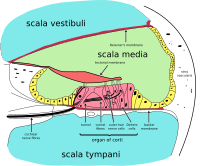
Photo from wikipedia
Introduction For the population with risk factors for hearing loss, the first option to assess the hearing status is the performance of the automated brainstem auditory evoked potential (BAEP) test… Click to show full abstract
Introduction For the population with risk factors for hearing loss, the first option to assess the hearing status is the performance of the automated brainstem auditory evoked potential (BAEP) test because of its efficacy in identifying retrocochlear hearing loss. Objective To verify the outcomes of automated BAEP performed in different settings as well as the factors associated with the prevalence of hearing impairment. Methods Cross-sectional study conducted from October of 2014 to May of 2015. The sample consisted of 161 infants with at least one risk factor for hearing loss who underwent automated BAEP during the hospital stay or at the outpatient clinic. After 30 days, the altered cases were referred for BAEP diagnosis. Results One hundred and thirty-eight infants (86%) had a result of “pass” and 23 (14%) of “failure” in the automated BAEP. There was no statistically significant difference in the rate of “referred” results between examinations performed in different settings. The infants' ages did not influence the number of abnormal cases. All of the 23 infants who presented a “referred” result in the automated BAEP, unilateral or bilateral, were sent for BAEP diagnosis, and out of these, 9 (39%) remained with at least some degree of alteration. The average age of diagnosis was 2.7 months. Conclusion The results of the automated BAEP were similar when performed during hospitalization or after discharge. Neither the age at the examination nor the gender of the patient influenced the prevalence of hearing loss.
Journal Title: International Archives of Otorhinolaryngology
Year Published: 2018
Link to full text (if available)
Share on Social Media: Sign Up to like & get
recommendations!